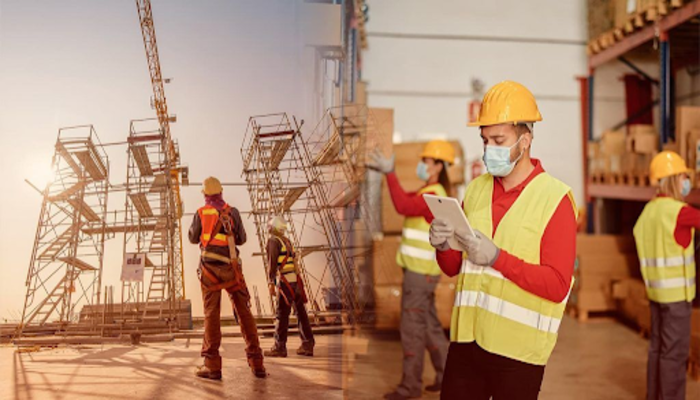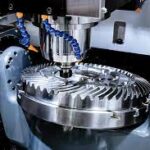Artificial Intelligence is becoming a crucial element in today’s world. Let’s find out its role in workplace safety.
Artificial Intelligence, often referred to as AI, is growing rapidly. From home appliances to major corporations, AI is unified in many things today, which indicates a feature enriched with AI-based solutions.
This should explain why experts predict the AI market’s compound annual growth to be around 38% until 2030. This also indicates the potential of AI and how it’ll grow into various industries and niches. That’s why we’re going to talk about AI’s role in workplace safety, predictive analysis, and safety compliance. So, let’s get started.
Brief Definition Of AI
The definition of AI depends on various factors. According to Oxford, the definition of AI is to “exhibit or stimulate” human-level intelligence. On the other hand, Merriam-Webster suggests artificial intelligence to be the capability of computers to “imitate intelligent human behavior.”
For instance, card swiping in grocery stores requires a human to do it. Nowadays, humans can check out at a self-checkout counter, where AI detects their debit/credit cards or mobile phone NFCs.
This is just one example of AI working in our everyday life. Other examples would be voice assistance in our phones and other devices, such as Alexa, Siri, or Google.
How Does AI Fit In Workplace Safety?
AI’s implantation in workplace safety isn’t something new. Ever since its invention, humans have thought of various ways to implement Artificial Intelligence to keep workers safe and secure. In 2019, Australia took the initiative to use wearable AI to assist workers in safety. This included:
- Work and safety goggles;
- Gloves and hand protection;
- Helmets and headcams to monitor safety situation;
- Robots and other machinery to accompany workers;
- And using machine learning data to prevent accidents.
So far, we’ve only talked about what AI can do for safety in the present. What about the future? AI’s branches, such as machine learning, are designed to comprehend human languages. Therefore, it can also assist AI by helping it understand the ailments and concerns of workers in a potentially hazardous workplace.
Therefore, predictive analytics for safety can be at the forefront for many companies in their venture to use Artificial Intelligence and safety compliance together. So, what might this entail? Here are a few things that some AI-based workplace safety programs already do:
- Use advanced algorithms to solidify safety values and ensure worker compliance;
- Promote safety culture by ensuring wearable gadgets and connecting them to a server;
- Observe and analyze behaviors and common values that might put workers at risk;
- Make advanced suggestions to prevent workplace hazards;
- Safety risk assessment through AI—be it software or gadgets;
- And implementing machine learning and safety to monitor regular inspections.
These methods allow many advanced-level companies to ensure the safety of their workers. It can also help them analyze with facial recognition which employee has or doesn’t have OSHA 30 construction or OSHA 10-hour training.
Therefore, it ensures workplace safety training for employees and assists with predictions. As a result, workplaces can be made 100s of times safer with the help of AI and its various branches.
How Can Workplaces Implement AI For Workplace Safety?
We have explored the basics and implementation of AI in workplace safety. So, how does an employer implement predictive analytics and safety compliance with the help of AI? Let’s talk about five common practices they can do:
Predictive Analysis
AI-based predictive analytics for safety is the process that employs AI and its branches to estimate possible safety failures, risks, and potential preventative measures. The statistical model can be designed according to the industry and provide a basic forecast on the back of machine learning.
How does it help workplace safety training? Because AI in workplace hazard identification can allow employers to understand which risky areas must only be granted to trained experts—be it trained in industry-specific skills or OSHA 10-hour training.
Measuring Incident Probability
Incident probability depends on established facts, past incidents, and the overall record for incidents in a particular place—for a particular industry. The programs that use AI for safety incident prediction use this data to analyze a few key aspects, such as:
- The likelihood of failure on the part of workers;
- The neglect of employer/workplace;
- And the lack of proper training in specific areas.
Therefore, a company can use AI and safety data analytics to predict possible incidents by measuring incident probability. Then, the old saying “better safe than sorry” can help prevent many a problem.
Implicating Data Analysis
Data analysis that is driven by machine learning and safety values can provide special and important insights into potential workplace hazards. This aspect of AI in workplace safety is particularly helpful for newer organizations. Because they can:
- Implement better rules;
- Train their employees better;
- And ensure proper use of equipment/machinery.
Therefore, by implicating data analysis, a company can use AI in safety inspections, hazard prevention, etc.
Data-Driven Decisions to Ensure Safety
Data-driven decisions aren’t that rare in potentially dangerous industries, such as OSHA’s big four: general industry, maritime, agriculture, and construction. Therefore, an employee can ensure that they provide OSHA 10-hour training and OSHA 30 construction workplace safety training to their workers.
Continuous Improvement & Flexibility
It might be a clichéd idea to improve and be flexible as you go along. However, AI for safety incident prediction has proven this cliché to be the utmost true. Not only does it help companies do better, but it also ensures better safety rules for many organizations around the globe.
Thus, an employer can use predictive analysis based on AI parameters to ensure continuous improvement and flexibility. Thus, ensuring the safety of their workers and supervisors, as well as expensive equipment.
Artificial Intelligence, often referred to as AI, is growing rapidly. From home appliances to major corporations, AI is unified in many things today, which indicates a feature enriched with AI-based solutions. According to market.us, Artificial Intelligence market is estimated to reach USD 2745 billion growing at a CAGR of 36.8% in next ten years.
Conclusion
These are the key factors of AI in workplace safety. It’s safe to assume that the future of AI and workplace safety is bound together, and more and more companies will jump on this train sooner or later. Therefore, it’s imperative to apply AI in workplace safety training.







